Can UV devices be the solution we seek to protect ourselves from the raging pandemic? Can they guarantee safety from coronavirus in our offices, restaurants, hotels, and even hospitals?
Almost every product advertised nowadays talks about its ability to kill the coronavirus. Yet very few do. One such category of products that claims to kill coronavirus is based on UV light. From hand-held scanners to air-conditioners, we are witnessing the launch of many products that promise eradication of coronavirus. But can these products really provide the miracle everyone is seeking? Can they make our homes, offices, and public spaces safe?
We spoke to experts and found that while UV based solutions, technically referred to as Ultraviolet Germicidal Irradiation (UVGI) solutions, can kill the virus, you have to be careful in selecting the right solution. If you select the wrong one, and let down your guard, rather than eliminating the menace of coronavirus you could end up increasing the threat. Ready to deep dive into the specifics?
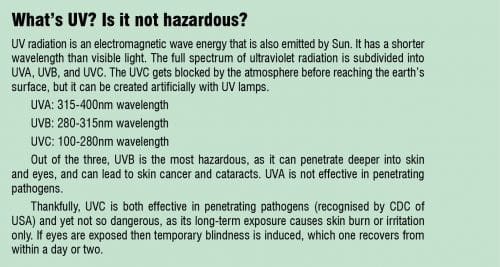
Reduce viral load, reduce transmission
As we all now know, Covid-19 infection is most virulent indoors. The infection-causing virus that affects human cells is tiny (20 to 400nm) and spreads in aerosol form from the infected persons. The aerosol floats in the air for hours and infects the persons in the room who inhale a heavy load of virus. Thus, any solution that can eliminate or reduce the viral load in a closed space promises to be an effective solution.
UVC: The virus killer?
Since 1950s, UVC rays of 100-280nm wavelength have been recognised as the most powerful germicidal radiation that can damage the DNA of pathogens like virus, bacteria, and fungus. The UVC radiation has been shown to destroy the outer protein coating of SARS-coronavirus, which is effective in inactivating the Covid-19 causing virus.
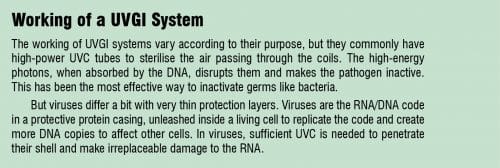
However, for UVC radiation to inactivate viruses, direct (line-of-sight) exposure is a necessity. Plus, the dose of UVC radiation and time are important factors.
“UVGI technology for contactless, fast, and effective disinfection is now becoming an important and effective tool for sterilisation and decontamination of surfaces in hospitals, quickly, efficiently, at lower cost. Although the science of UVGI technology for pathogen sterilisation in hospitals has been known in the world and used since the last 70 years, its use is now becoming very popular for infection control, as antibiotics-resistant pathogens have rendered medicines ineffective. Fortunately, there is no known pathogen that cannot be killed by a strong dose of UV germicidal irradiation; since UVC is not found in nature, pathogens have not developed resistance to it,” shares Vineet K. Rohatgi, Binay Opto Electronics Private Limited, Kolkata.
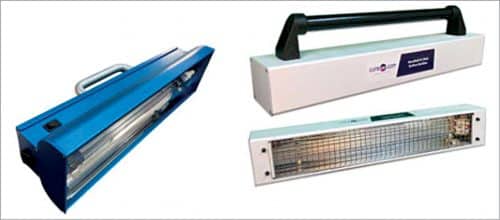
Harness UVC to disinfect
UVGI has historically been used in unoccupied spaces for a variety of applications to disinfect food, air, water, etc but usually in unoccupied spaces only. However, recent innovations in UVGI have enabled the introduction of systems suitable to sanitise the surfaces of spaces like hospitals, offices, restaurants, fitness centres, and more in human presence. And they all are powered by UVC. Plus, UVC light has replaced chlorine in purifying water.
Surface decontamination through static or portable light disinfection, air decontamination through air handling units, HVAC disinfection, localised air sanitisers, upper-air disinfection and lower room luminaires, object decontamination through UVGI chamber, and water decontamination are primary applications of UVGI.
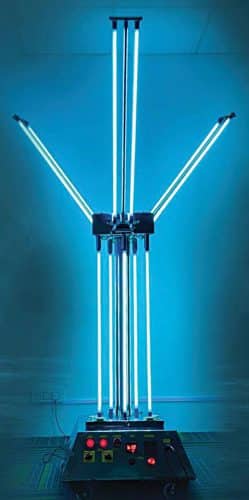
Sanitising surfaces and rooms
Sanitising of surfaces, commonly prone to spread of infections, can be done by UVC. This has led to portable handheld sanitising devices becoming popular in commercial markets. However, handheld devices will work only when they get adequate time for exposure. Plus, as distance changes so does the strength of UVC, so the user must maintain the right distance and time to achieve decontamination. Else, a false sense of security may prevail, leading to potential disasters.
“At the time of purchase, users should check and verify the actual UVC intensity of the device. If the UVC output power is too low, the handheld device will be unable to eradicate pathogens, as time required to achieve the required dose will be impractically long,” explains Rohatgi. Plus, it would be prudent to wear eye protection goggles to avoid any damage to eyes.
Mobile carts with UVC lamps are commonly used for operation theatre disinfection in countries like the USA. These carts are robotically controlled or manually wheeled around the room. Many of them are now remotely controlled with the help of a hand-held remote, mobile app, or power switches. But these are best used in the absence of humans. Some modern devices feature human-sensing capabilities to emit warning if a human being steps into the room when the UVC lamp is on to prevent any form of injury. Since 2020, we have witnessed introduction of many mobile robots that conduct UVC based sanitisation in the absence of humans. Many of them come with the ‘autonomous movement’ capability so that they can sanitise the space without human intervention.
Decontaminating the air
As mentioned earlier, inhalation of air carrying fine droplets of infectious virus are now identified as the primary cause for the spread of coronavirus, including the Delta variant. The risk varies with respect to the amount of virus (aka virus load) a person is exposed to. Enclosed spaces with inadequate ventilation or air circulation, combined with prolonged exposure, increase the risk of virus transmission exponentially.
CDC recommends that the entire air of a room must be refreshed twelve times every hour, that is, the entire room’s air refreshed every five minutes. This rate of refreshing the air reduces the viral load to levels where chances of transmission become negligible. For details, refer to https://www.cdc.gov/coronavirus/2019-ncov/hcp/infection-control-recommendations.html
Historically, UVC was already being used to decontaminate air for other pathogens. Let us see how effective different solutions already in play are, and whether any customisations can make them more effective.
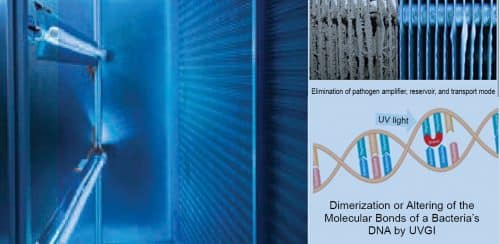
Solutions for centralised ACs and AHUs
Centralised air-conditioning is obviously a prime candidate for trouble. While high-efficiency particulate air (HEPA) filters are in place since quite some time, technology improvements have led to the installation of UVGI systems in the air handling units (AHUs). Herein, UVC lamps are installed at the site of condenser coils, the breeding place for germs due to moist condensing water and dust.
Irradiating the cooling coils with UVC radiation ensures there is no growth of germs, dust accumulation, and sterilisation of pathogens within the time it passes through the coils. This solution helps to prevent the spread of airborne disease from one room to another at a low cost. But in most cases this setup cannot prevent localised in-room transmission of infection, as the rate of refreshing of air is not as high as twelve refreshers per hour. A great exception is a typical aircraft, which has AHUs that refresh air at much faster rate, thus eliminating the risk of coronavirus to a considerable degree.
In-duct solutions
In-duct UVGI systems are installed within a heating, ventilation, and air-conditioning (HVAC) system. These devices are installed in the outlet duct for rooms and disinfect with a high power dose of UVC. A special treatment of the UVGI keeps the HVAC coils, drain pans, and moist surfaces free of pathogens and produces relatively low levels of UV energy throughout the day.
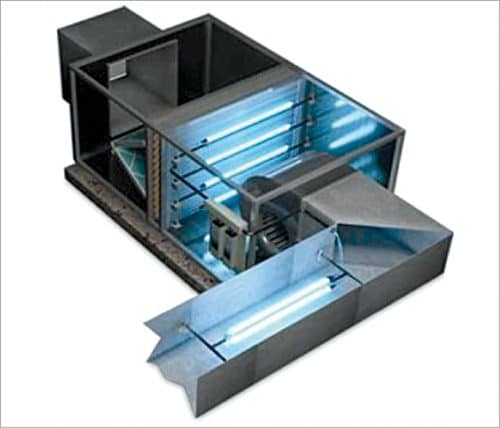
Coil treatment UVGIs is not recommended for disinfecting air but can be used in HVAC systems to improve operational efficiency. Air-disinfection UVGI installed within the HVAC duct can be effective in disinfecting, as it generally requires more powerful UV lamps. This has better disinfection, particularly if the air is recirculated in the room.
Air purifiers
This is one product category that has seen a large jump in sales since the onset of coronavirus in early 2020. While many are buying non-UV powered air purifiers with the wrong assumption that they will kill coronavirus too, some are buying newly launched UVC integrated units. These units come with UVC lamps installed near their suction blowers so that when placed in a room they can decontaminate the air that passes.
But there are a few risks here. First, the power of the UVC lamp must be adequate to kill the virus within the limited time it will have to disinfect the air. Second, very few have the blower powerful enough to refresh the room twelve times an hour. Hence, they may not reduce the viral load to safe levels, except for very small rooms. Thus, while they will provide an improvement over conventional (HEPA-filter) air purifiers, if adequate safety measures are not maintained the virus may still spread despite the investment!
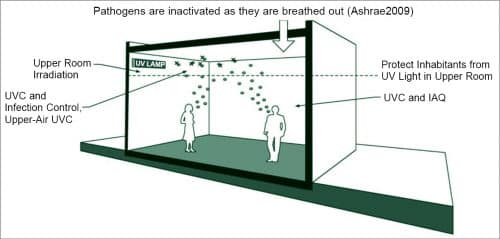
Lower-air disinfectants
Over time, pathogens tend to settle downwards, and get accumulated on the floor. These are blown into the air by human movement from one room to another. Lower-air room disinfectants can be used to decontaminate the floors along with the walls uniformly to maintain them in sterile condition and prevent the spread of virus.
Such devices are mounted on a wall at a height of 450 to 600mm above ground level. This has less risk of human exposure and wearing normal full-length pants and footwear can protect occupants further. These are usually recommended for corridors leading to sterile zones.
Upper-air disinfectants
These have proven to be the most effective solution for controlling airborne infections including coronavirus. Remember that due to the large volume of air, it is not possible for most HVACs or centralised AC units to refresh air every five minutes. And, as the size of space increases, so does the inadequacy of the centralised units.
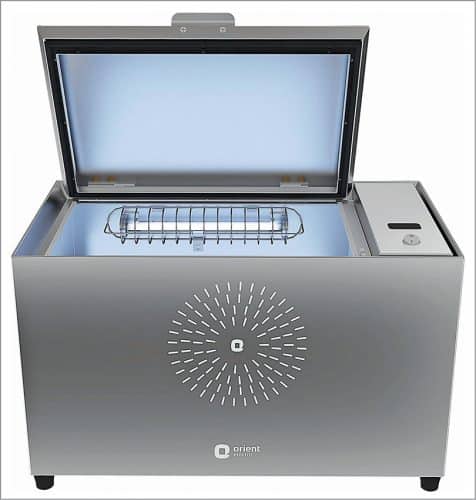
According to the CDC, “UV research on SARS-CoV-2 indicates that the virus that causes Covid-19 is very similar to other coronaviruses (for example, SARS and MERS) regarding the UV dose necessary to inactivate it. Upper-room UVGI systems can be used to control SARS-CoV-2 as a useful ventilation tool to consider for reducing the spread of infectious pathogens.”
Upper-room disinfectants tackle the challenge of refreshing the air quickly by working on a room-wise basis. Frankly, they seem to deploy many of the common-sense principles that have been in existence for quite some time now, and hence no one holds a patent to this tech either.
They work on the principle that hot air, when you exhale, rises before cooling and settling down. Thus, by placing UV luminary devices at a height just above our heads they eliminate pathogens as soon as one exhales, thereby eliminating chances of transmission.
And some units come with suction blowers which also suck the air upwards towards the unit so that speed and effectiveness of decontamination increases, thereby further reducing the viral load.
Since they are able to disinfect air closer to and above people in a room, they can be deployed even in high-risk indoor settings where adequate natural ventilation is not possible. “To minimise UVC exposure, upper-air disinfection solutions could be used without significant risk for long-term effects such as skin cancer. Upper-air UVC device construction and placement prevents excessive UV energy from striking occupants below,” adds Hina Gupta.
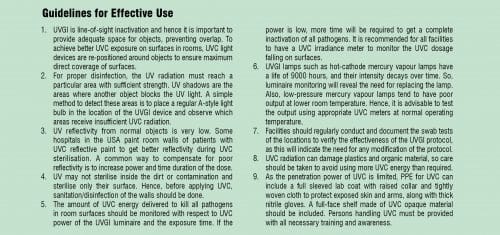
UV chambers
UVGI chambers are commonly used for sterilisation of medical equipment, electronic instruments, PPE masks, and other small objects. These typically come with a timer to manage the period of exposure to UV. For effectiveness, the chamber must be designed in such a way that UVC light falls all around the object placed inside. Precautions should be taken to place objects with adequate space between them to avoid overlaying. The UVC light must be shut down completely before opening the chamber and care should be taken if the lamp inside emits ozone.
UV doors and corridors
UVC radiation cannot be used directly on humans due to its harmful nature. However, experts are working on designing UVGI walk-through corridors with a safe level of 222nm UVC, especially for personnel treating Covid-19 patients. These will allow reuse of the PPE kit, as after decontamination, it will be safe to touch and wash with chemical disinfectants.
UV-C lamps: Competing technologies
The heart of any UVGI system is the light source, which can be from special lamps or LEDs. The most common UV light sources include mercury vapour discharge lamps, amalgam lamps, excimer lamps, and xenon lamps.
Hot-cathode, low-pressure mercury vapour lamps, which resemble fluorescent lamps without fluorescent coating, may be incorporated with UVC transmitting glass, UVC transparent soft glass, fused quartz with titanium, amalgam of mercury or indium, which blocks the mercury vapour emitting a portion of energy at 185nm, producing ozone.
Mercury lamps are currently the most cost-effective due to their high electrical to optical conversion efficiency. However, mercury lamps have a risk of toxicity. Physically, they are less robust and are also temperature sensitive, hence their monitoring is necessary. In the case of quartz glass, careful maintenance and cleaning is important. Amalgam lamps can operate at high power and have relatively longer life. Xenon lamps work in high-intensity flashes of arc discharge that deliver a large spectrum of wavelengths including UVC, UVB, UVA, and visible light. This needs filtration to remove other wavelengths; these are not commonly found in India.
A new kind of UVC lamp, the krypton chlorine excimer lamp (KRCL), has been developed that generates UVC radiation of 222nm (aka far-UVC). It is mechanically more robust than other sources. The shorter UV wavelengths from an excimer lamp are found to be lethal to germs but do not harm the human body as they do not penetrate the upper layer. It is currently under rigorous testing and hopefully would be found safe for humans.
UVGI LEDs based on aluminium gallium nitride, which can emit UVC light in 265nm to 280nm range, are showing promising results as a viable source of UVC light emission. UVC LEDs are compact, small, and can be easily used in portable UV disinfectant solutions. They can have a high life in excess of 50,000 hours, which can be a boon for continuous use and low maintenance.
Their UVC emission efficiency is low, typically 2 to 5 percent, but unlike mercury lamps that have several lines of emission, UVC LEDs can emit only a narrow band of emissions.
However, it has the risk of exposure to the human eye as one may assume the UVC LED is turned off when it is actually on. Hence it is advised to use it only along with a secondary warning light.
The cost of UVC LEDs remains higher than mercury based light sources but is expected to come down. A recent study by researchers at University of Miyazaki (Japan) demonstrated that irradiation with a deep ultraviolet LEDs of 280nm wavelength rapidly inactivated SARS-CoV-2.
Far-UVC. Far-UVC is an emerging technology that employs different lamps to emit UV energy at a wavelength of around 222nm. It is marketed as safe for exposing humans and their direct environment to UV energy. The FDA refers to a study by scientists from the Centre for Radiological Research, Columbia University Irving Medical Centre that states far-UVC light of 222nm wavelength efficiently and safely inactivates airborne human coronavirus. The research shows far-UVC to reduce the presence of viruses, including various strains of coronavirus and influenza, up to 99.9 percent.
“Germicidal UVC light, typically at 254nm, is effective in inactivating viruses but when used directly can pose a health hazard to skin and eyes. Instead, far-UVC light (207 to 222nm) can efficiently destroy pathogens, potentially without causing harm to exposed human tissues. Continuous exposure to far-UVC in occupied public areas at the current regulatory exposure limit (~3mJ/cm2/hour) would cause ~90% viral deactivation in ~8 minutes, 95% in ~11 minutes, 99% in ~16 minutes, and 99.9% deactivation in ~25 minutes. According to current regulatory dose limits, low-dose-rate, far-UVC exposure can result in a major reduction in the ambient level of airborne coronaviruses in occupied public areas,” says Hina Gupta.
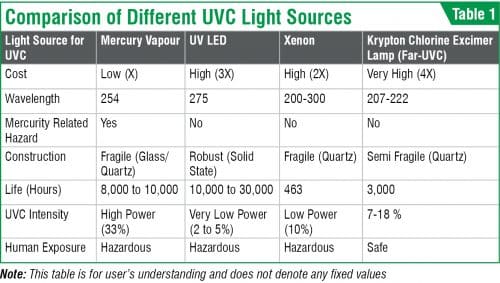
Need for standards
A key challenge inhibiting growth in adoption of UVC products is the growing confusion due to lack of standards and guidelines. In the absence of standards, it is challenging for end-users to figure out whether the solution being invested in will be effective for their use-case or not. The worst mistake would be to invest in an ineffective solution and let down your guard.
“UVC lights for disinfection purpose being imported and sold in Indian market are basically of two types, germicidal lamps and LED types. Germicidal lamps can be used for surface disinfection purpose only and cannot be used in human presence. UVC LED lights are very popular these days but 99% of these lights are fake and do not kill any viruses. There must be some testing and certifications by authorities regarding UVC lights for disinfection purposes. Currently, there are few standards available globally for UVC devices, but the pandemic has triggered the need to regulate human safety and official standards over the growing use of UVC. While most of the standards available now are on human safety levels and protocols for UVC use, standards are yet to be defined for reliability and performance of devices being sold,” says Hardev Singh, Director, Universal Electronics.
Some of the standards related to UVC are:
- ISO has a standard for human safety and permissible exposure from UVC (ISO 15858:2016).
- National Institute for Occupational Safety and Health certification (NIOSH), USA has specified the maximum human exposure to 254nm UVC light at 6000 microjoules/sq cm in a period of eight hours.
- Electrical safety standards for UVGI luminaries are defined by BIS 10322.
- The International Electrotechnical Commission has set up IEC62471 for photobiological safety of lamps and lamp systems, which provides guidance for the evaluation of photobiological safety of all electrically powered non-laser sources of optical radiation emitting in a spectral range of 200 to 3000nm.
- International UL 1995 standard is applied to UV lamps that are factory- and field-installed for HVAC&R equipment. ASHRAE Technical Committee (TC) 2.9 for ultraviolet air and surface treatment helps supervise safety standards that protect installers and service personnel from accidental UVC exposure from HVAC&R equipment. By applying safety features within the AHU, UL 1995, 5th edition standard seeks to remove variations in the design of the device that might lead to accidental exposure.
- International UL 2043 standard is for fire test for heat and visible smoke release for discrete products installed in AHU space. It addresses the concern for contribution to smoke density or flame propagation by the equipment during a fire.
“Manufacturers follow the standards and guidelines prescribed in the handbook ‘UVGI for Air and Surface disinfection’ authored by Wladyslaw Kowalski. For buyers, it is important to check the intensity test certificate. These certificates provided by authorised laboratories to the manufacturer can be a proof for the amount of intensity used by a specific product for irradiation,” opines Sreejith Swaminathan, Senior Product Manager, Zedbee Technologies.
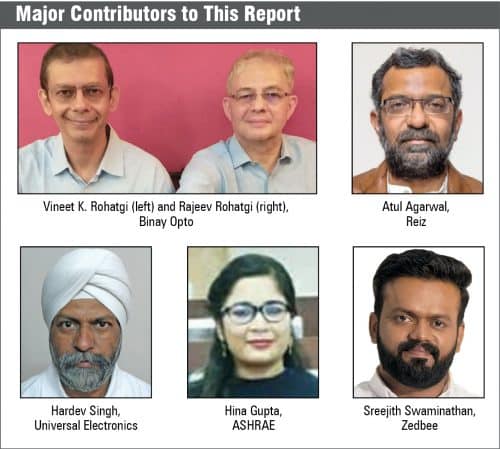
Practices and precautions
While many people have started installing UVGI systems in public places, these require maintenance and monitoring with respect to the lamp used to discharge the UVC radiation. “UVGI is a science and use of UVGI technology must be understood by the user before applying, as it can be harmful to humans, and if not monitored properly, ineffective for the pathogens that it is required to destroy, with serious consequences of infections,” says Rohatgi.
Unlike UVA and UVB, lower wavelengths of UVC prevent its penetration deep into the skin. Thus, there is not much risk when exposure is for a limited period of time. But, prolonged continuous exposure has been linked to reduced immunity and can cause cancer. NIOSH and IEC have fixed a maximum UVC of 254nm as allowable dose for human exposure in an eight hour workday. This should be pursued with a period of rest to allow the body to regenerate to withstand UVC again.
“LED based UVC products are preferred due to long lasting durability, and they are not affected by temperature. We have partnered with Council of Scientific & Industrial Research to work on UVC systems to sanitise aircrafts, and we have already taken up sanitisation projects in metros along with the DMRC (Delhi Metro Rail Corporation),” says Atul Agarwal, Technical Director, Reiz Electrocontrols.
Mercury lamp sources generate ozone that poses severe harm to living cells of the human body, leading to chest pain, coughing, throat irritation, and can even be fatal. To counter this issue, leading manufacturers use UVC tubes made of glass or quartz, which reduce the emission of ozone into the atmosphere.
To UVC or not to UVC?
After one year of the pandemic, CDC (USA) concluded after extensive studies that Covid-19 is primarily an airborne disease. In fact, one of the studies concluded that 9,900-plus cases out of 10,000 are airborne infection cases. Thus, the need to disinfect the air in enclosed spaces is very, very vital.
Here is how UVC solutions could be of help:
- Install UVC solutions in central air-conditioning units to disinfect the air so that infection cannot spread from room to room.
- Install in-duct UVC solutions to treat circulated air.
- To prevent in-room infection, which is the most popular mode of infection, it is imperative to disinfect the air in the room, for which you have following options:
- Enclosed UVC devices. These suck in air and subject it to a very high dose of UVC energy to disinfect the air. This option, while effective for small rooms, does not disinfect fast enough in larger rooms to prevent infection.
- Enclosed room air filters with UVC. These often use HEPA filters, which limit air flow and have a slow air delivery, so are again not very effective to prevent infection in a room.
- Upper-room air UVC solutions. These have the fastest mode of room air disinfection. Studies have shown that even with basic air circulation, air disinfection rates equivalent to 24 air-changes-per-hour have been achieved.
Overall, it is clear that UVC does present many solutions to fight coronavirus. Be it in our homes or public spaces, there seem to be solutions we can invest in. For many businesses, these may be the best investment to ensure continuity of their operations by providing safety and security for their customers, and their employees. Upper-room luminaries and lower-room luminaries seem to stand out amongst all, for most cases.
This report was compiled by Abbinaya Kuzhanthaivel with key inputs from Vineet Rohatgi, Director, Binay Opto Electronics, and Hina Gupta, Director, ASHRAE India.







Wonderfully compiled dear Abbinaya
Very detailed and informative article.
Thank you for your valuable feedback.